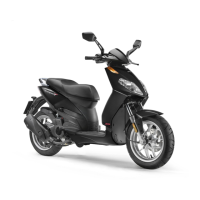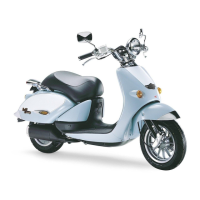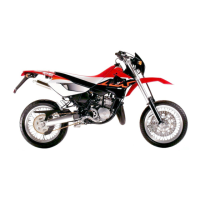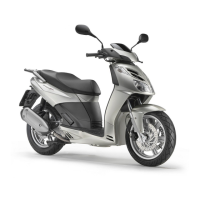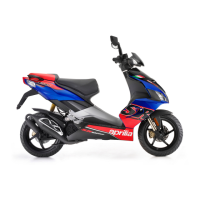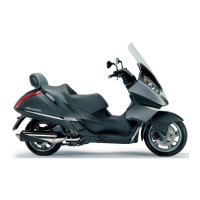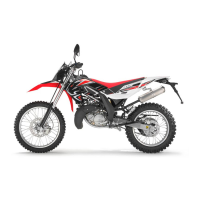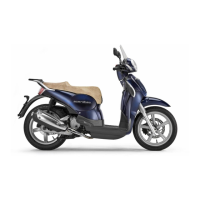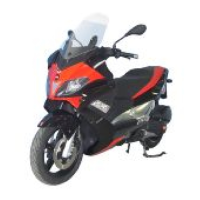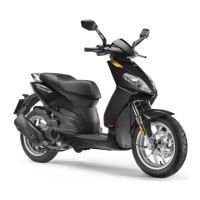
Do you have a question about the APRILIA SPORTCITY 125 - 2004 and is the answer not in the manual?
| Brand | APRILIA |
|---|---|
| Model | SPORTCITY 125 - 2004 |
| Category | Motorcycle |
| Language | English |
Read manual, especially "SAFE DRIVE" section.
Depends on reflexes, agility, knowledge, and basic rules of "SAFE RIDING".
Certain substances affect riding; be in good psychophysical condition.
Wear and fasten helmet correctly, ensure it complies with regulations.
Wear bright/reflective clothing for visibility and protection.
Shows and lists electrical controls on the left side of the handlebar.
Shows and lists electrical controls on the right side of the handlebar.
Illustration showing the dashboard instruments and indicators with numbered labels.
Lists numbered instruments and indicators with their functions.
Details the function of each instrument and indicator.
Controls located on the left side of the handlebar.
Controls located on the right side of the handlebar.
Describes the function of the ignition switch and its position.
Explains selection of clock, odometer, trip meter, battery voltage.
Steps to unlock and lock the vehicle seat.
Information on fuel handling, safety, type, capacity, and procedure.
Information on oil handling, safety, environmental concerns, and transmission fluid.
Periodically check engine oil level.
Schedule for engine oil changes.
Check brake disc and friction material for cleanliness.
Information on brake safety, disc/pad cleaning, and fluid change.
Fluid level decreases as pads wear; check reservoirs on handlebar.
Steps to check the brake fluid level using the glass gauge.
Periodically check coolant level; change every 2 years.
Do not release into environment; keep away from children.
Remove front cover and check fluid level between MIN and MAX marks.
Steps to loosen filler plug, release pressure, and top up coolant.
A quick pre-ride check improves safety and takes only minutes.
Table detailing pre-ride checks for various vehicle parts and their corresponding pages.
Steps to start the vehicle, including positioning, switches, and brake application.
Rotate throttle grip slightly if engine doesn't start within seconds.
Do not use vehicle with insufficient engine oil to avoid damage.
Starting may be difficult below 0°C; use specific procedure.
Procedure for starting in cold weather.
Release throttle, adjust idle if erratic.
Procedure to clean a flooded engine by cranking with open throttle.
Press starter button for ten seconds to fill float chamber.
What the low fuel light indicates and when to refuel.
Keep hands on handlebar, feet on footpegs; maintain recommended position.
Steps to move off, including throttle, brake, and balance.
Release brake lever and accelerate moderately.
Ride slowly to warm up engine for reduced emissions and fuel consumption.
Do not open/close throttle repeatedly; lose control.
Close throttle, use both brakes smoothly for braking.
Ride slowly on wet/slippery surfaces, avoid sudden braking/swerving.
Release throttle, apply brakes gradually; keep one brake applied for brief stops.
Correct running-in ensures proper performance and durability.
Avoid fully opening throttle; brake gently for first 100 km; limit speed for first 500 km.
Stop vehicle, set engine stop switch, turn ignition switch, lock steering.
Stop engine, remove key, allow cooling, ensure ventilation.
Lists operations by interval and indicates who can perform them.
Details specific operations and intervals for dealer service.
Steps to check engine oil level when the engine is cool.
Procedure for topping up engine oil.
Steps to remove, clean, and oil the air filter element.
Instructions for cleaning the air filter element.
Steps to visually inspect brake pads using a flashlight and mirror.
Change pads when lining material is worn to nearly 1.5 mm or wear indicators are visible.
How to adjust spring preload using the ring nut.
Steps to remove the spark plug carefully.
Battery fluid is toxic, caustic, and corrosive; wear protective gear.
Never invert battery cables.
Steps to remove the battery compartment cover and the battery itself.
Steps to charge the battery using a suitable charger.
Charge in well-ventilated place; do not inhale gases.
Steps to refit the battery and connect cables.
Do not repair faulty fuses; never use a fuse of a different rating.
Steps to remove, check, and replace fuses.
Steps to adjust the headlight beam using screws.
Lists bulb types and wattages for various lights.
Steps to remove tail light fairing and lens to change bulbs.
Ensure area is well ventilated, do not inhale vapors, no smoking or open flames.
Risk of fire; let engine cool; fuel vapors are noxious.
Steps to drain the fuel tank using a pump.
Steps to drain the carburettor completely.
Take precautions to avoid damage when vehicle is unused for long periods.
Steps for preparing vehicle for long-term storage.
Steps after removing vehicle from storage.
Test ride vehicle at moderate speed in an area away from traffic.
Table listing various dimensional specifications of the vehicle.
Details of engine type, displacement, bore, stroke, etc.
Lists capacities such as fuel, engine oil, coolant, and maximum load.
Specifies brake type and diameter.
Lists recommended engine oil brands and specifications.
Lists recommended transmission oil brands and specifications.
Lists recommended fork oil brands and specifications, including mixing.
Shows the electrical wiring diagram of the vehicle.
Lists numbered electrical components and their descriptions.
